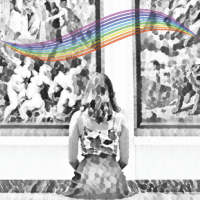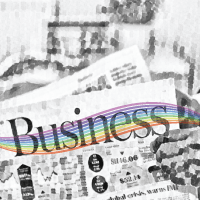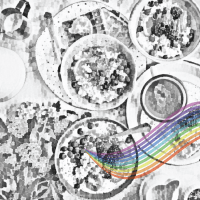- Atilla Tiriyaki
- Average Reading Time: 6 minutes
- Community, Non binary
- articles, atillat, nonbinary
Many of the labels and terms used to reference LGBTQIA+ people are relatively new. For example, words such as Lesbian and Homosexual only started to be used in the 1860s. Other LGBTQIA+ labels and terms have only become part of many modern languages and vocabularies worldwide since the 1950s. Though some of the words may only be 20 years or more old, it does not mean people historically did not identify in that way. Instead, it likely means that there were no labels or simple ways to describe their thoughts or feelings.
It is believed that the terms genderless or non-binary came about during the mid-1990s. The term was initially used to describe people moving between genders or those who could not identify exclusively as male or female. In order to understand gender identities better, it is easier to break them down into two parts; the gender or sex assigned at birth and gender expectations.
From week fourteen onwards during pregnancy, the gender or sex of a baby can be established. The gender is determined based on the presence of the x or y chromosome; male babies will typically have the y chromosome and female babies with the x chromosome. Once born, their gender is assigned based on their physical and anatomic appearance, often referred to as the gender or sex assigned at birth.
Our gender is being used and referenced for the rest of our lives, especially within official documentation, such as birth certificates and passports. It will often influence our identity, rights, freedoms, and how the world perceives us from birth until we die. The older we become, the more aware we are of our gender. People are not born with a guide of what it means to be male or female. Instead, how we act, behave, and what is expected is influenced and taught by our families, media and society as a whole.
In contrast to our genders assigned at birth, gender expectations are not physical. Instead, they are heavily influenced by our environments. Gender roles often vary by culture, social-economic groups, religious beliefs and even how accepting and tolerant any given society is towards its local communities. The definition and what it means to be male or female will often vary by area, country, region and continent. Suppose you compared someone growing within Thailand as male to the same in Norway. Their influences and experiences would likely be very different.
With gender expectations being taught, anyone growing up within a given society who wants to conform and fit it would have to follow the gender guidelines accepted by that community. When you factor in often antiquated gender stereotypes, such as all women like pink and all men love sports and so-called traditional values, it can become difficult. Many might be forced to live in societies that suppress who they are or result in them living in a way that they do not feel comfortable portraying.
Now that we have gone through those two key factors, let us explore how they directly relate to the gender scale. Suppose you are born a male; the older you become, the more you begin to feel different and question your identity. You might not think that you can identify or conform to the definitions of male or female, exclusively based on your perception of gender expectations. For people in that situation, they would likely identify as non-binary or genderless.
The gender scale is just that, a scale of opposite forms, with the male identity on one end and the female identity on the other end of the scale. When people refer to binary, they are talking about the two opposite genders, male and female. Genderless or nonbinary individuals might identify at the mid-centre point of the scale, if at all. In comparison, gender-fluid individuals might see how they identify change frequently, whether in small increments or large swings from either side of the gender scale.
A common misconception by many is that by identifying as non-binary, the individual would also likely identify as transgender or gay, which is simply not incorrect. However, the actual answer is a little more involved, but let us explain why the misconception is not valid.
A transgender individual is born one sex or gender, say male; however, identifies with the opposite gender, in this example, as female. Many of those that identify as transgender are suffering from a condition known as body dysmorphia. The condition makes those affected dislike their bodies. It creates the desire to change their physical appearance to reflect how they think and feel on the inside, ultimately their true identity. Though some non-binary people may also identify as transgender, many will not. For most non-binary individuals, it is not about changing their appearance to look like the opposite sex; instead, it is about not exclusively identifying with either sex or gender.
Now concerning sexuality. Sexuality will often come down to a person’s perspective. Anyone who classifies a person’s sexuality in a binary way might find it simpler; however, they will usually be incorrect. For example, a binary definition of sexuality for a person born or assigned the gender or sex at birth, say, male. They would be categorised as gay if they were physically attracted to other men and straight if they were attracted to women.
Though non-binary individuals might be categorised as gay using binary definitions, they might not identify in that way. When you identify as non-binary, you will not identify as male or female exclusively, so you would not define yourself as male in that example. If you do not identify as male, then if you form relationships with other men, you might not consider yourself gay. With that principle in mind, non-binary sexualities and relationships using conventional definitions could be categorised as straight, gay, bisexual or any other non-traditional sexual identity.
Gender and sexual identities are not mutually exclusive. Some LGBTQIA+ individuals might identify with more than one sexual or gender identities. However, many individuals will often likely only identify with one.
LGBTQIA+ identities often come down to public and personal perceptions. How people see an individual, their appearance, and any relationships they might form will often be different from how they see themselves. Suppose you see yourself as male, whereas others who do not know you may perceive you as female or do not identify as male and the world sees you as gay. In both cases, it ultimately comes down to those you come into contact with and their willingness to accept and respect how you choose to live your life.
Some in society might not always agree with how people identify or choose to live; regardless of individual beliefs, people’s rights to choose should still be respected. The majority of LGBTQIA+ individuals seek the freedom to live ordinary and peaceful lives, not hurting or out to hurt anyone, simply living as their true and authentic selves. How they choose to live and identify is up to them, and any decisions they make are there’s alone. LGBTQIA+ identities are important; however, we must acknowledge that they are not the only thing that defines who they are as a person.
Ultimately, people around the world should have the right and freedom to choose how they wish to live their lives and, of course, whomever they want to form relationships with and love
PRIDE IN NON-BINARY
More from Gayther
Discover all of the exciting and entertaining articles written by people from the worldwide LGBTQIA+ community, sharing their stories, opinions and experiences in their own style and from their unique perspectives










